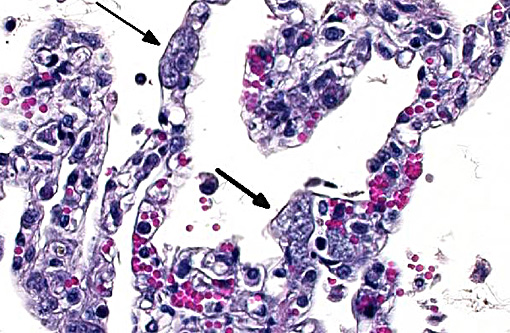Signalment:
Gross Description:
Histopathologic Description:
Morphologic Diagnosis:
Lab Results:
| Parameter | ||
| HCT(%) | 20.6 | 30-45 |
| MCV (fl) | 45.2 | 39-55 |
| MCHC (g/dL) | 33.1 | 30-36 |
| RDW | 18.3 | 11-17 |
| Platelets (/uL) | 28,000 | 200,000-700,000 |
| Reticulocyte Count (/uL) | 3,000 | 15,000-81,000 |
| WBC (/uL) | 2,460 | 5,500-19,500 |
| Neutrophils (/uL) | 812 | 2,500-12,500 |
| Bands (/uL) | 1,255 | 0-300 |
| Total Protein (g/dL) | 4.73 | 6.2-7.7 |
| Albumin (g/dL) | 2.0 | 2.8-4.2 |
| Globulin (g/dL) | 2.7 | 2.4-4.4 |
| Total Bilirubin (mg/dL) | 9.78 | 0. 1-0.2 |
| Blood Urea Nitrogen (mg/dL) | 50.1 | 5-30 |
Treatment and case outcome: Intravenous crystalloid fluids and broad-spectrum antibiotics were initiated on the night of 6/14/08, along with one unit of packed red blood cells. The next morning the cat was still dull and dysphoric and soon developed cardiac and respiratory arrest. Resuscitation efforts were unsuccessful. A necropsy was performed.
Condition:
Contributor Comment:
Previously, antemortem diagnosis was made by identification of erythrocyte piroplasms, but PCR assays for this agent are now available. This more sensitive method of detection has lead to the identification of cats that either have subclinical infection or that have recovered from an infection and become chronic carriers.(2) Genetic variability of Cytauxzoon felis has been proposed as a possible explanation for why some animals recover from infection or fail to develop clinical signs.(1)
JPC Diagnosis:
1. Lymph node: Lymphadenitis, histiocytic, diffuse, mild, with lymphoid depletion, hemorrhage, thrombosis, and numerous intravascular intrahistiocytic schizonts.
2. Lung: Pneumonia, interstitial, histiocytic, diffuse, mild, with numerous intravascular intrahistiocytic schizonts.
Conference Comment:
The disease is uncommon, but often fatal in cats when it occurs.(4) The intrahistiocytic phase leads to systemic circulatory compromise due to partial or complete vascular obstruction.(4) The erythrocytic phase is characterized by persistent parasitemia with anemia which may exacerbate ischemic tissue damage. Ischemic damage can also cause cerebral necrosis, appearing similar in some respects to feline ischemic encephalopathy and thiamine deficiency.(3) Dyspnea is also common clinical finding of infected cats, and interstitial pneumonia seems to be a consistent finding and may be the largest contributor to respiratory difficulty, possibly leading to acute respiratory distress syndrome in some cases.(5)
References:
1. Brown HM, Berghaus RD, et al. Genetic variability of Cytauxzoon felis from 88 infected domestic cats in Arkansas and Georgia. J Vet Diagn Invest 21:59-63; 2009.
2. Brown HM, Latimer KS, et al. Detection of persistent Cytauxzoon felis infection by polymerase chain reaction in three asymptomatic domestic cats. J Vet Digan Invest 20:485-488; 2008.
3. Clarke LL, Rissi DR. Neuropathology of natural Cytauxzoon felis infection in domestic cats. Vet Pathol. 2015 Jan 8. pii: 0300985814564986. [Epub ahead of print]
4. Fry WM, McGavin MD: Bone Marrow Blood Cells and Lymphatic System In: Pathologic Basis of Veterinary Disease, eds. McGavin MD and Zachary JF, 4th ed., pp.783. Mosby, Inc., Philadelphia, 2007.
5. Snider TA, Confer AW, Payton ME. Pulmonary histopathology of Cytauxzoon felis infections in the cat. Vet Pathol. 2010;47(4): 698-702.
6. Valli VEO: Hematopoietic System In: Jubb, Kennedy, and Palmer's Pathology of Domestic Animals, Vol 3. ed. Maxie MG. 5th ed., pp 243. Saunders, Philadelphia,2007.


